Credit & Copyright: C. Hogan,
Fermilab
Explanation:
How different are space and time at very small scales?
To explore the unfamiliar domain of the miniscule
Planck scale -- where normally
unnoticeable quantum effects might become dominant -- a newly developed instrument
called the Fermilab
Holometer has begun operating at
the
Fermi National Accelerator Laboratory
(Fermilab)
near Chicago,
Illinois,
USA.
The instrument seeks to determine if slight but simultaneous jiggles of a mirror
in two directions expose a fundamental type of
holographic noise
that always exceeds a minimum amount.
Pictured above is one of the end mirrors of a
Holometer prototype.
Although the discovery of
holographic noise
would surely be groundbreaking, the dependence of such noise on a specific laboratory
length scale would
surprise
some
spacetime enthusiasts.
One reason for this is the
Lorentz Invariance
postulate of Einstein's
special relativity,
which states that all length scales should appear contracted to a relatively moving
observer -- even the diminutive Planck
length.
Still,
the
experiment is unique and many are
curious what the results will show.
Astrophysicists:
Browse 900+ codes in the Astrophysics Source Code Library
1999 2000 2001 2002 2003 2004 2005 2006 2007 2008 2009 2010 2011 2012 2013 2014 2015 2016 2017 2018 2019 2020 2021 2022 2023 2024 2025 |
Январь Февраль Март Апрель Май Июнь Июль Август Сентябрь Октябрь Ноябрь Декабрь |
NASA Web Site Statements, Warnings, and Disclaimers
NASA Official: Jay Norris. Specific rights apply.
A service of: LHEA at NASA / GSFC
& Michigan Tech. U.
|
Публикации с ключевыми словами:
теория относительности - голография
Публикации со словами: теория относительности - голография | |
См. также:
Все публикации на ту же тему >> | |
